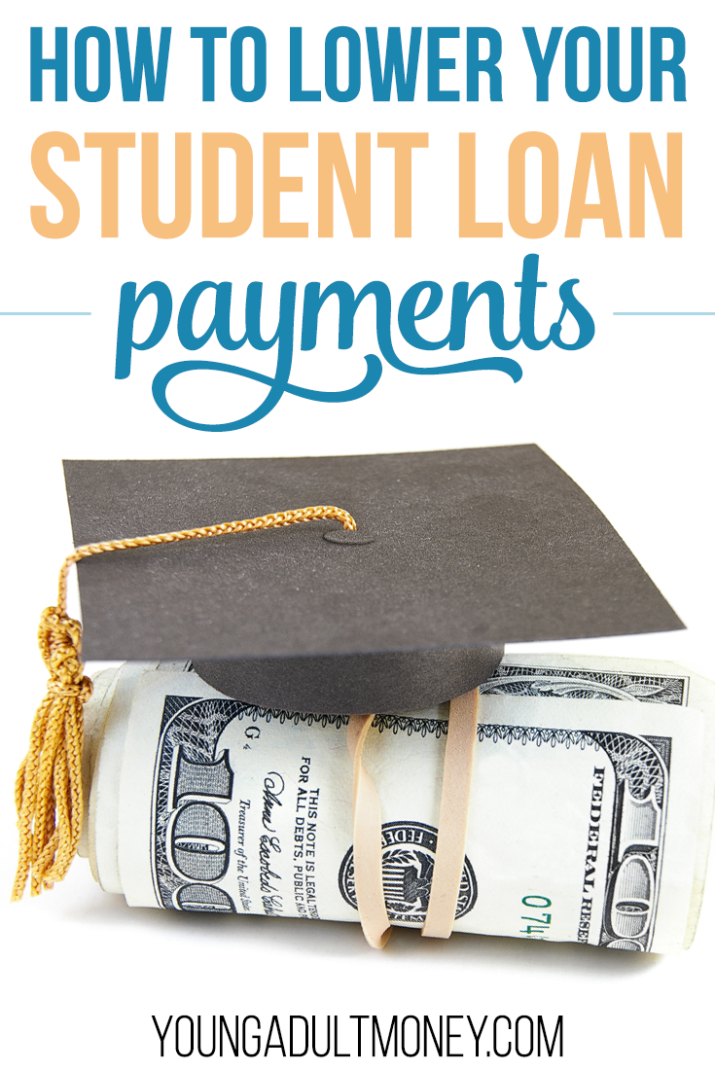 Is your high student loan payment affecting your ability to meet your other living expenses?
Is your high student loan payment affecting your ability to meet your other living expenses?
Having any type of debt can often hold you back from saving more, investing more, and using your money for leisure purposes but when your monthly student loan bill is as high as your rent/mortgage or grocery budget, it can seem very disheartening.
While I recommend a combination of spending less and earning more help you pay off large amounts of debt, if you feel your student loan payment is too high and starting to become unmanageable, here are some options to help you lower your minimum payment.
Apply For an Income-Driven Repayment Plan
Income-driven repayment plans were designed to help federal borrowers base their minimum monthly payments on how much they earn. Under income-based repayment, student loan payments are capped at 10 – 15% of your discretionary income.
Not all types of federal student loans are eligible. Only borrowers with these types of student loans may take advantage of an income-driven repayment plan.
- Direct Subsidized loans
- Unsubsidized loans
- Direct Graduate PLUS loans
- Stafford loans
- FFEL Consolidation Loans
- Federal Direct Consolidation Loans
If you do have any of these federal student loans and are struggling to make your minimum monthly payment, you can apply for an income-driven repayment plan (you must apply each year) and will be eligible for student loan forgiveness after 25 years.
Below are a few common types of income-driven repayment plans.
Pay As You Earn (PAYE)
This plan was introduced in 2012 and requires that you’ve taken out student loans on or after October, 2007. You must also prove you need financial assistance with repaying your loans and your monthly payments will be no more than 10% of your discretionary income. All loans are eligible for forgiveness after 20 years.
Income-Based Repayment Plan
This is an option to consider when your current income doesn’t support your minimum monthly student loan payment. Payments are capped at 10-15% of your discretionary income but could be as low as $0 if you have no income.
Income Contingent Repayment
Your income isn’t required in order to qualify for this type of payment option. Monthly payments are calculated at 20% of your discretionary income and the repayment term is 25 years.
Keep in mind that a contingent repayment plan may not be more affordable than your standard repayment plan so you really want to make sure there’s a savings opportunity before you switch to this plan.
$100k in Student Loan Debt: What I Did About It
Switch to a Graduated Repayment Plan
This is an option for federal student loan borrowers that I took when I started paying back my loans. The graduated student loan repayment plan allows your minimum monthly payments to start out low and increase over time with the idea that your income will increase over time.
When I graduated, I didn’t know what my income was going to be so I decided to use this repayment plan. Every two years the minimum payment increases by a little.
The great thing about this option is that you can stick to a lower payment term of 10 years.
Refinance Your Loans
If you have private student loans and your payment is too high, refinancing them can potentially lower your interest rate and in turn, save you money. You will need a good credit score to be eligible for refinance.
If you’re interested in refinancing or even curious about how much you could save, you can get a free rate quote at SoFi.
Sign Up For Autopay
One of the simplest ways to lower how much you end up paying on your student loans is to sign up for autopay to reduce your interest rate.
I also did this with my federal loans and it reduced my interest rate by .25%. I’m not sure if private lenders do this as well, but you ask your lender for an interest rate discount for signing up for autopay.
Putting your student loans on autopay is great to do anyway because it helps ensure you never miss a payment or make a late payment and missing a payment can cause your student loans to go into default.
Also, by lowering your interest through this option, your payment amount may remain around the same, but you’ll reduce how much you spend on interest over time.
What to Keep In Mind When Lowering Your Student Loan Payment
Lowering your student loan payment can be beneficial to your finances now and make your debt more manageable, but you also have to keep in mind how some of these options may affect you in the future.
If a reduced student loan payment allows you to extend your repayment term, you’ll be paying less now but paying more overall. For example, going from a 10-year repayment term to a 20-year term will lighten your burden now, but you could be paying tens of thousands of extra dollars on your loans for the next two decades as a result.
Hence why it’s also best to consider all your options and the possible long-term effects of the decision you make.
However, if you’re struggling to meet your basic payment requirements, lowering your payment is a solid option to help you avoid not being able to pay on your loans at all which would put you in an even worse situation.
If you’re going through a financial hardship right now, it makes sense to attempt to lower your student loan payment then make additional payments to catch up when you get back on your feet financially.
My only caution is to realize that you could be spending more money to pay off your loans in the long run and to only consider lowering your payment if it is unaffordable and not allowing you to live comfortably.
Have you ever considered lowering your student loan payment before? Would you ever consider refinancing your student loans to save money now and in the future?


Good tips Chonce. I used a few of these when I was paying off my student loans. I ran into the issue of extending the payment terms a few years though. Like you said, I wouldn’t recommend that in most situations. Getting that relief feels good, until you realize it’s actually costing you more money.
I don’t think it’s necessarily a bad idea if you truly can’t afford to make your student loan payments. It’s better than not paying anything at all and over the life of your term, your finances can change and improve and you can always make extra payments on your loans. That’s what I’m doing now so I don’t regret getting a graduated payment plan right off the bat because now I pay like 5x that amount each month.
Great tips. I don’t remember all the federal repayment options existing like they did when I graduated in 2008. I’m sure they were there but most of my loans were private since I needed to borrow more than the federal limit each year & I think the interest rate was lower for one or two years.
I suggest autopay for everybody. It’s basically “free” money if you keep enough in your bank account each year.